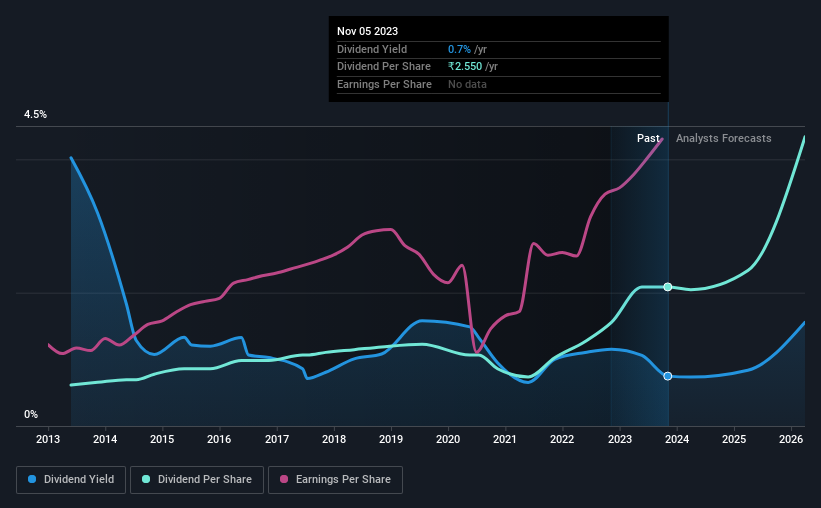- India
- /
- Auto Components
- /
- NSEI:GABRIEL
Gabriel India (NSE:GABRIEL) Is Paying Out A Larger Dividend Than Last Year
Gabriel India Limited's (NSE:GABRIEL) periodic dividend will be increasing on the 2nd of December to ₹1.50, with investors receiving 67% more than last year's ₹0.90. The payment will take the dividend yield to 0.7%, which is in line with the average for the industry.
While the dividend yield is important for income investors, it is also important to consider any large share price moves, as this will generally outweigh any gains from distributions. Investors will be pleased to see that Gabriel India's stock price has increased by 57% in the last 3 months, which is good for shareholders and can also explain a decrease in the dividend yield.
Check out our latest analysis for Gabriel India
Gabriel India's Dividend Is Well Covered By Earnings
We like a dividend to be consistent over the long term, so checking whether it is sustainable is important. Before making this announcement, Gabriel India was easily earning enough to cover the dividend. This means that most of what the business earns is being used to help it grow.
The next year is set to see EPS grow by 124.3%. If the dividend continues along recent trends, we estimate the payout ratio will be 15%, which is in the range that makes us comfortable with the sustainability of the dividend.

Dividend Volatility
The company has a long dividend track record, but it doesn't look great with cuts in the past. Since 2013, the dividend has gone from ₹0.75 total annually to ₹2.55. This works out to be a compound annual growth rate (CAGR) of approximately 13% a year over that time. Despite the rapid growth in the dividend over the past number of years, we have seen the payments go down the past as well, so that makes us cautious.
We Could See Gabriel India's Dividend Growing
With a relatively unstable dividend, it's even more important to evaluate if earnings per share is growing, which could point to a growing dividend in the future. It's encouraging to see that Gabriel India has been growing its earnings per share at 8.0% a year over the past five years. With a decent amount of growth and a low payout ratio, we think this bodes well for Gabriel India's prospects of growing its dividend payments in the future.
Gabriel India Looks Like A Great Dividend Stock
Overall, a dividend increase is always good, and we think that Gabriel India is a strong income stock thanks to its track record and growing earnings. Distributions are quite easily covered by earnings, which are also being converted to cash flows. Taking this all into consideration, this looks like it could be a good dividend opportunity.
Market movements attest to how highly valued a consistent dividend policy is compared to one which is more unpredictable. At the same time, there are other factors our readers should be conscious of before pouring capital into a stock. Taking the debate a bit further, we've identified 2 warning signs for Gabriel India that investors need to be conscious of moving forward. If you are a dividend investor, you might also want to look at our curated list of high yield dividend stocks.
Mobile Infrastructure for Defense and Disaster
The next wave in robotics isn't humanoid. Its fully autonomous towers delivering 5G, ISR, and radar in under 30 minutes, anywhere.
Get the investor briefing before the next round of contracts
Sponsored On Behalf of CiTechNew: Manage All Your Stock Portfolios in One Place
We've created the ultimate portfolio companion for stock investors, and it's free.
• Connect an unlimited number of Portfolios and see your total in one currency
• Be alerted to new Warning Signs or Risks via email or mobile
• Track the Fair Value of your stocks
Have feedback on this article? Concerned about the content? Get in touch with us directly. Alternatively, email editorial-team (at) simplywallst.com.
This article by Simply Wall St is general in nature. We provide commentary based on historical data and analyst forecasts only using an unbiased methodology and our articles are not intended to be financial advice. It does not constitute a recommendation to buy or sell any stock, and does not take account of your objectives, or your financial situation. We aim to bring you long-term focused analysis driven by fundamental data. Note that our analysis may not factor in the latest price-sensitive company announcements or qualitative material. Simply Wall St has no position in any stocks mentioned.
About NSEI:GABRIEL
Gabriel India
Manufactures and sells of ride control products to the automotive industry in India, the Netherlands, and internationally.
High growth potential with excellent balance sheet.
Similar Companies
Market Insights
Weekly Picks

Early mover in a fast growing industry. Likely to experience share price volatility as they scale


A case for CA$31.80 (undiluted), aka 8,616% upside from CA$0.37 (an 86 bagger!).


Moderation and Stabilisation: HOLD: Fair Price based on a 4-year Cycle is $12.08
Recently Updated Narratives

Automotive Electronics Manufacturer Consistent and Stable

Airbnb Stock: Platform Growth in a World of Saturation and Scrutiny

Adobe Stock: AI-Fueled ARR Growth Pushes Guidance Higher, But Cost Pressures Loom
Popular Narratives


Crazy Undervalued 42 Baggers Silver Play (Active & Running Mine)


NVDA: Expanding AI Demand Will Drive Major Data Center Investments Through 2026


The AI Infrastructure Giant Grows Into Its Valuation
Trending Discussion




